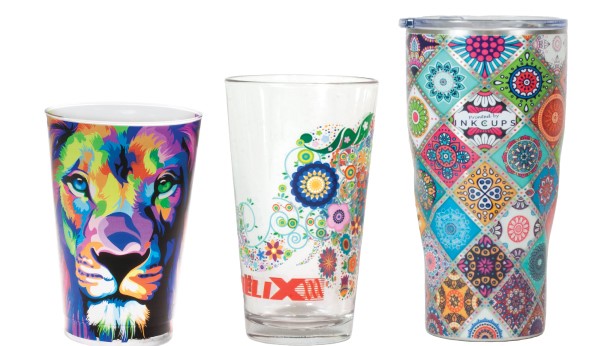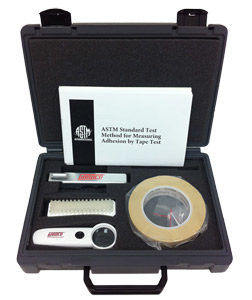
Optimal UV ink adhesion all begins with the chosen substrate of choice. For instance, a glass pint glass will not have the same process as stainless-steel wine tumbler. Never fear, our specialists at Inkcups are happy to recommend the correct route for your substrate. After all, the substrate is the stepping stone for which ink to use, and if both a primer and pre-treatment are required.
UV ink adhesion can be enhanced by three main components: UV ink, primer, and the method of pre-treatment. Dependent upon the substrate Inkcups offers many different methods of pre-treatments and primers to chose from for long lasting results. Even the correct choice of ink itself comes into play to warrant strong adhesion.
Prior to choosing colors or graphics, one needs to be confident ink will stick to the chosen substrate. Here at Inkcups we take our time to test your product with different inks, primers, and pre-treatment options to come up with a customized regime for you. It is all part of our Inkcups Advantage.
Certain substrates require specialized UV inks. Inkcups offers six different UV LED curable inks to accommodate any substrate you look to print on. Both surface tension and drying time come into play when selecting the correct type of UV ink. The surface tension of the substrate and the ink must align. If the surface tensions do not align the ink will bead off the surface. For optimal adhesion, the surface tension of the ink must be less than the surface tension of the substrate.
Your substrate and intended use of substrate will indicate the combination of primer and pre-treatment needed, or rather the lack thereof. For instance, a pint glass which could be expected to be washed hundreds of times will require a more robust adhesion than that of a candle holder that would never encounter a dish washer. Inkcups is happy to advise you on if a primer and pre-treatment are needed for your product.
Inkcups offers eight different UV inkjet primers. Substrate materials range from polypropylene to coated metals to glass. Just like ink, primer is specific to the type of material being printed on to ensure proper and long lasting adhesion. Not only are there numerous types of primers, but there are multiple ways to apply primer to a substrate. Primers can be either wiped or sprayed on.
The most basic and cheapest option for pre-treatment is the primer wipe. One can manually wipe a lint-free towel loaded with primer onto the substrate. This method requires nothing more than manual labor, the lint free towel, and primer itself. However, due to its basic nature, superior abrasion resistance is not promised. The wipe on primer method is used primarily for glass substrates.
MagiCoat® is a water-based primer for glass that combines parts A, B, and C to be sprayed onto the substrate immediately after a flame treatment. The combination of the flame and sprayable primer allows the item to withstand up to 200 residential washes.
The MagiCoat® Pre-Treatment system houses a flame treatment system as well as a spraying system for primers. The flame portion of the treatment removes coatings and debris found on the surface of the substrate. The system has 8 individually rotating systems and can pre-treat as many as 15 items per minute.
Flame pre-treatment is a common practice to magnify ink adhesion through the manipulation of surface tension.
The first step in the flame pre-treatment process is wiping down the glass substrate with a lint free towel or with an isopropyl alcohol wipe. Flame pre-treatment aims to increase surface energy of the glass therefor increasing wettability by utilizing the extreme temperatures attained within the oxidation layer of the flame. The wettability is important to the adhesion as it is the ability of a liquid to maintain contact with a substrate. Wettability is measure in degrees, the smaller angle the better the wetting.
One of the leading industry flame pre-treatment methods is Pyrosil®. Pyrosil® is an additional component added into a flame treatment. It eliminates issues that flame treatment alone cannot overcome, such as cold end coating, contamination, and mold.
The Autoflame 360 Flame Treatment Machine automates the flame treatment process in one piece of machinery. Eight bottles can be cued up on the machine, each being vacuum sealed to the individual palette. One at a time each bottle is rotated 360 degrees on the palette while being flame treated. Bottles leave the Autoflame 360 by an automatic unload onto a transfer chute to ensure no bottle passes by the flame more than once.
The Plasma pre-treatment changes the surface tension of the substrate by using the plasma portion of a flame on a substrate.
The Corona pre-treatment alters the surface tension by taking an electrical type of charge to the surface of the substrate. It increases adhesion and removes any debris at the same time. The corona pre-treatment is strong enough to stand alone, often eliminating the need for any accompanying pre-treatment method.

For your convivence we have all of the necessary tools readily available in-house to test your substrate. To begin the process, simply fill a sample request form. From that form we can have a better idea of your adhesion expectations and needs. To start the process officially we will ask you to mail in 10 to 15 samples of your substrate.
To test for passing adhesion Inkcups abides by ASTM’s standardized tests of tape, scratch, Crosshatch A, and Crosshatch B. The title of each type of adhesion test doubles as a link to a YouTube video of the respective testing method.
Our goal is to meet or exceed customers expectations when it comes to everything we do. We are happy to go the extra mile and continue testing your substrate with three additional tests if applicable.
Did you know Inkcups has a podcast? Check our our channel on Spotify, Specialty Printing. To hear an in-depth explanation on adhesion testing listen to Matthew’s episode, Ink Adhesion Testing Methods.
Back to Blog Home
Add Your Comment